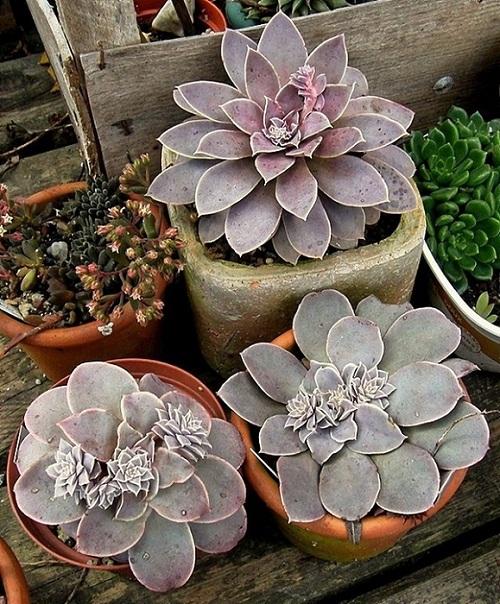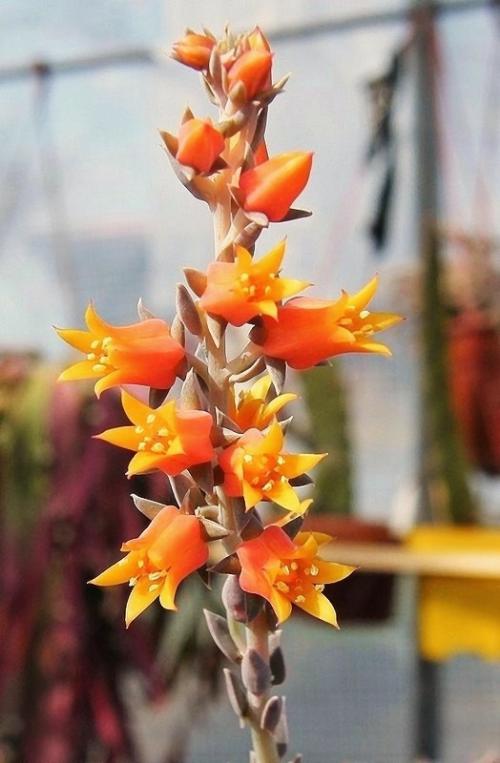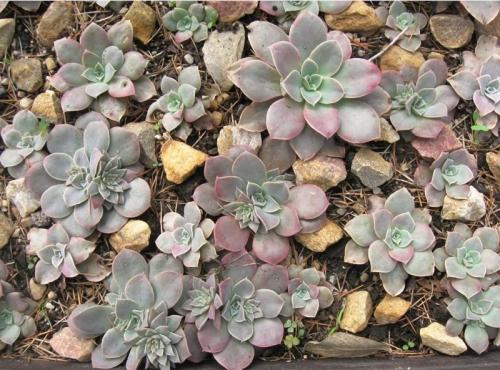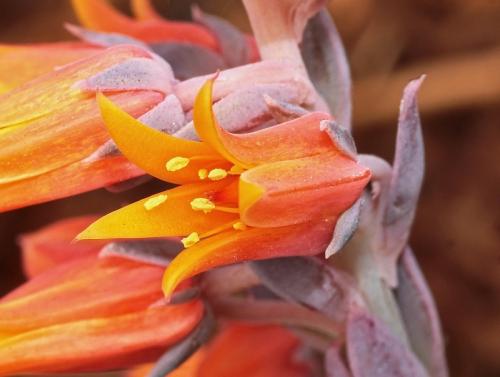DIFFRACTENS Kimnach & Lau, 1981 (engl./ fr.)
Series Racemosae
Type : Lau 070. collected W on road from Palma Sola to Plan de las Hayas, at 300 m, Veracruz, Mexico.
Etymology : Latin, breaking into pieces, shattering : for the easily detached bracts.
Distribution : Mexico (Veracruz).
First Description by Kimnach and Lau in Cactus and Succulent Journal US 53(1): 4-7.1981 :
Rosette usually solitary, rarely with one offset, rather flattened, 7 – 10 cm wide and 2 – 3 cm high, of 30 – 40 leaves.
Stem to 2 cm long or more, ca 1.5 cm thick.
Leaves rosulate, the younger ones ascending, the older rotate and lying flat against substratum, the younger ovate-deltoid and acute, the older oblanceolate and obtuse but with an acute cusp ca 2 mm long, the oldest 3.5 – 4.5 cm long, 10 – 12 mm wide at base, 17 – 22 mm wide above, 2 – 3 mm thick, the lower surface convex, the upper surface entirely concave on young leaves, concave on apical third on older leaves, eventually flat or somewhat convex; margin acute, sometimes undulate on young leaves; leaf-colour light pinkish-grey-violet, the older leaves becoming slightly greener, the young leaves with a white margin ca 0.5 mm wide, the epidermis smooth, the cells not protruding.
Floral stems first appearing in July, flowering in November-December, 2 – 6 on each plant, erect at first, decumbent to pendent with age, usually unbranched, rarely with up to three branches near base, racemose, equilateral except that pedicels curve toward strongest-lit side; peduncle 11 – 27 cm long, 2 – 6 mm thick near base, 2 – 3 mm thick just below lowest pedicel, light olive-green, slightly glaucous; bracts numerous and conspicuous, 3 – 5 mm apart, easily detached, ascending, obovate-oblong to elliptic, acute, mucronate, 10 – 20 mm long, 4 - 9 mm wide, 2 – 3 mm thick, with an obtuse basal spur less than 1 mm long, convex on both surfaces, colored as the leaves.
Inflorescence ascending, 5 – 8 cm long, the rachis 2 – 3 mm thick, pseudopedicels usally horizontal or somewhat pendent on decumbent floral stems, 13 – 16 mm long, the lower ones sometimes branched and producing another younger, more basal flower, ca 1 mm thick, slightly thicker just below calyx, usually bearing 1 – 2 bracteoles less than 1 mm long.
Flowers : Calyx disc 3 – 4 mm wide, the lobes unequal, ascending, ovate-lanceolate, acute, 4 – 6 mm long, 1.5 – 2.5 mm wide, 1 – 1.5 mm thick, glaucous, coloured as the leaves; corolla conoid-urceolate, with pronounced subacute angles, 11 -13 mm long, 6 – 7 mm thick near base, 4 – 5 mm thick 3 mm below apex, the limb 6 – 9 mm wide; petals connate basally for ca 1 mm, triangular-lanceolate, long-acuminate, the apices expanding, 11 – 13 mm long, ca 3 mm wide near base, the lower three-fourths subacutely keeled on exterior, shiny, the exterior entirely orange, or often with the apical 4 or 5 mm yellow, the interior yellow tinged with light orange; epipetalous filaments 6 mm long, adnate to corolla for ca 1 mm, the antesepalous 7 mm long, free to base, all filaments yellowish, the anthers ca 1 mm long and 0.5 mm wide, light yellow; nectaries truncate, semicircular in cross-section, 1.5 mm wide, 0.75 mm thick, cream; gynoecium turbinate, 9 – 10 mm long, 4 mm thick just above base, orange-red-dotted, the pistils and styles appressed along whole length.
Cytology : n = 18



